Enterprise System Analysis: Nestle Company Report, BISY2005
VerifiedAdded on 2022/08/17
|17
|4121
|11
Report
AI Summary
This report examines the implementation of an enterprise system within Nestle, a global food and beverage company. It begins with an executive summary and introduction, followed by a description of Nestle's organizational structure and operations. The report identifies business problems faced by ...
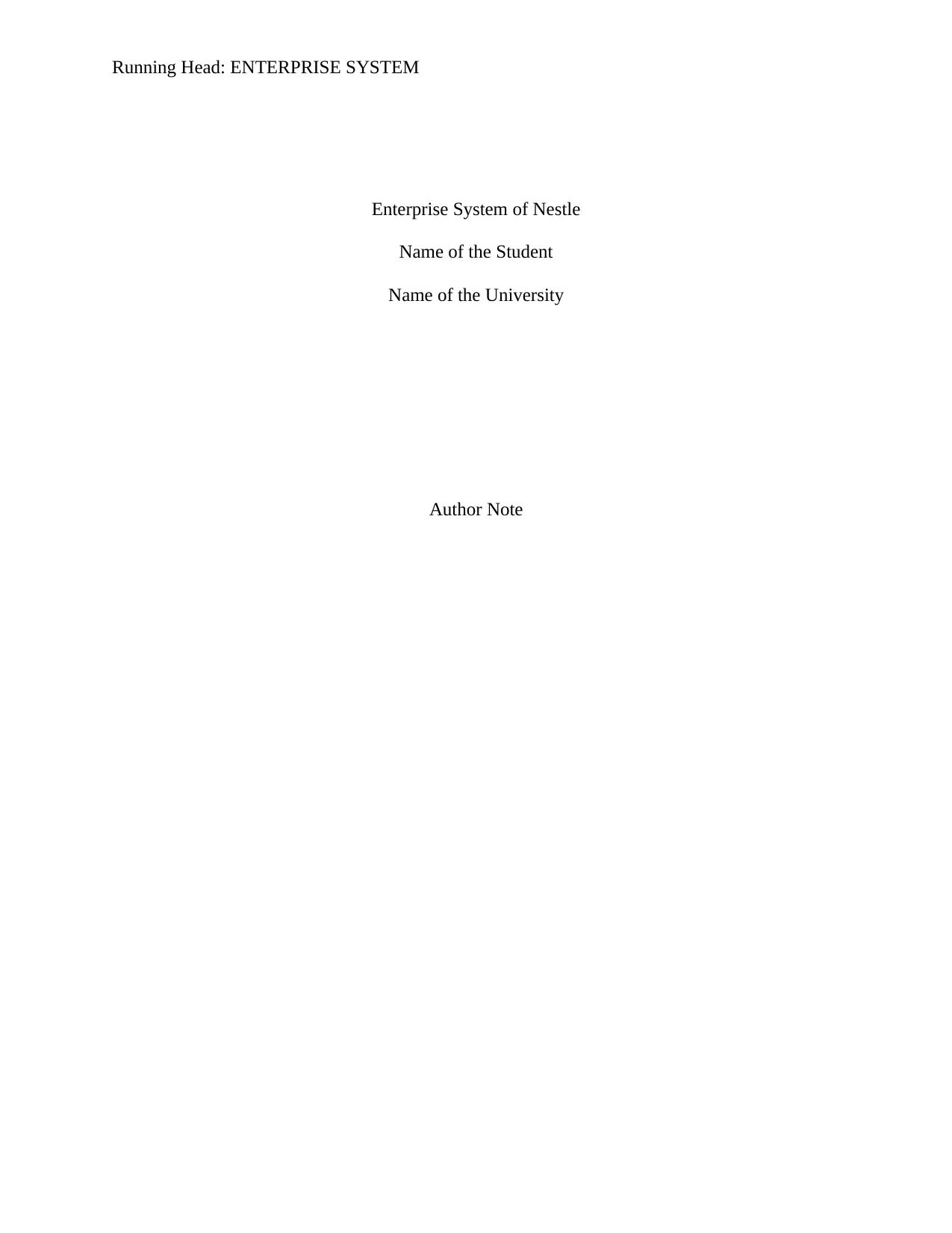
Running Head: ENTERPRISE SYSTEM
Enterprise System of Nestle
Name of the Student
Name of the University
Author Note
Enterprise System of Nestle
Name of the Student
Name of the University
Author Note
Secure Best Marks with AI Grader
Need help grading? Try our AI Grader for instant feedback on your assignments.
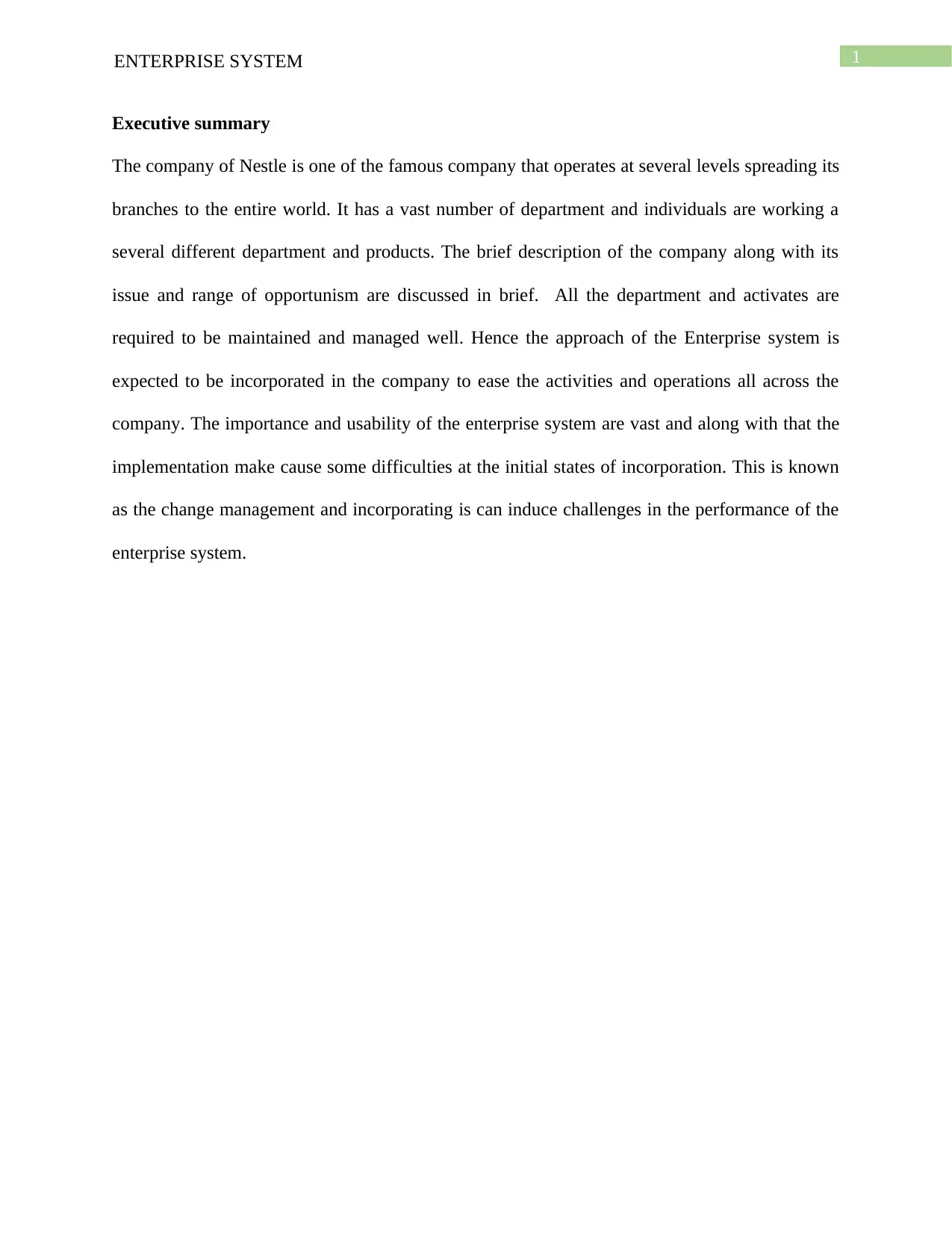
1ENTERPRISE SYSTEM
Executive summary
The company of Nestle is one of the famous company that operates at several levels spreading its
branches to the entire world. It has a vast number of department and individuals are working a
several different department and products. The brief description of the company along with its
issue and range of opportunism are discussed in brief. All the department and activates are
required to be maintained and managed well. Hence the approach of the Enterprise system is
expected to be incorporated in the company to ease the activities and operations all across the
company. The importance and usability of the enterprise system are vast and along with that the
implementation make cause some difficulties at the initial states of incorporation. This is known
as the change management and incorporating is can induce challenges in the performance of the
enterprise system.
Executive summary
The company of Nestle is one of the famous company that operates at several levels spreading its
branches to the entire world. It has a vast number of department and individuals are working a
several different department and products. The brief description of the company along with its
issue and range of opportunism are discussed in brief. All the department and activates are
required to be maintained and managed well. Hence the approach of the Enterprise system is
expected to be incorporated in the company to ease the activities and operations all across the
company. The importance and usability of the enterprise system are vast and along with that the
implementation make cause some difficulties at the initial states of incorporation. This is known
as the change management and incorporating is can induce challenges in the performance of the
enterprise system.
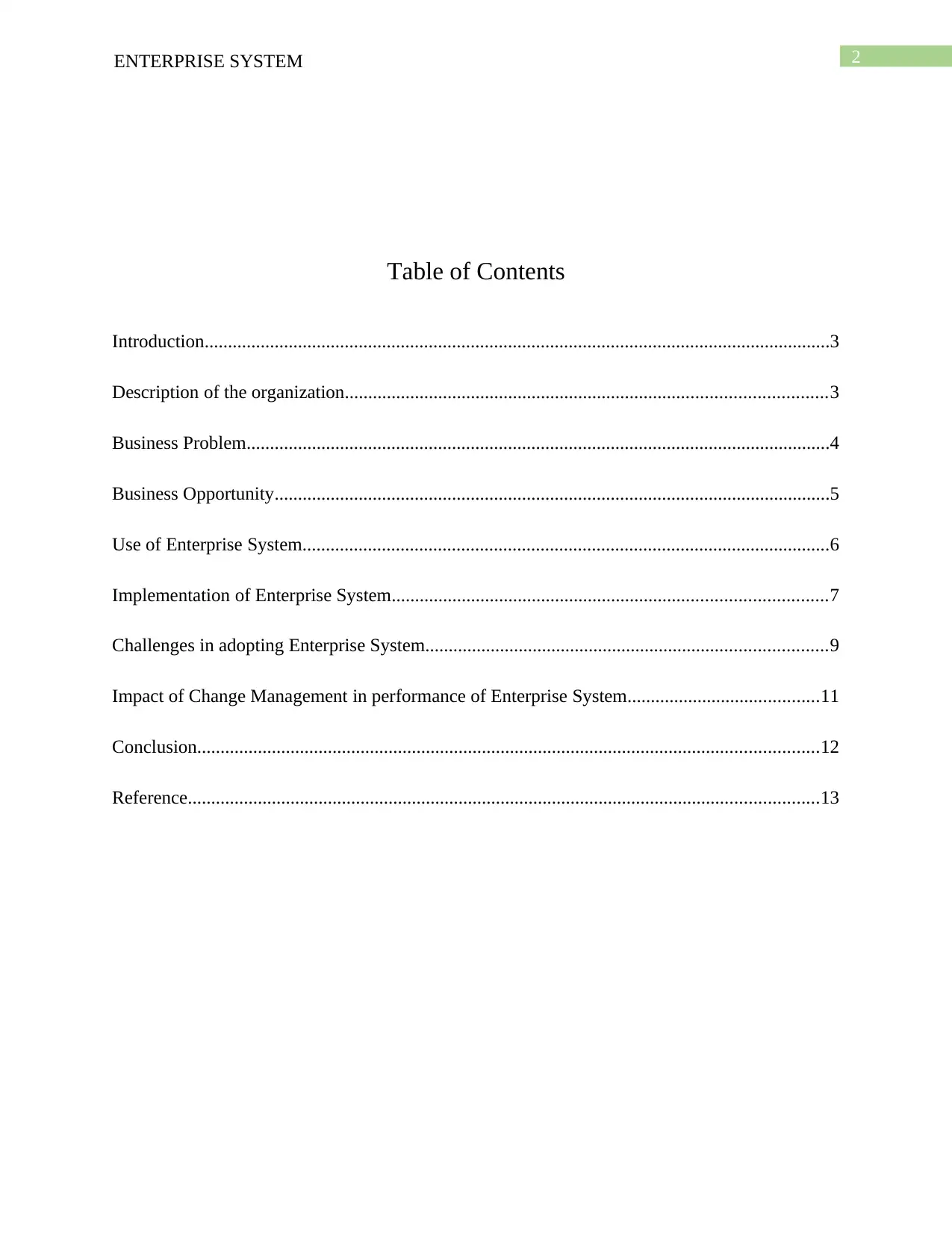
2ENTERPRISE SYSTEM
Table of Contents
Introduction......................................................................................................................................3
Description of the organization.......................................................................................................3
Business Problem.............................................................................................................................4
Business Opportunity.......................................................................................................................5
Use of Enterprise System.................................................................................................................6
Implementation of Enterprise System.............................................................................................7
Challenges in adopting Enterprise System......................................................................................9
Impact of Change Management in performance of Enterprise System.........................................11
Conclusion.....................................................................................................................................12
Reference.......................................................................................................................................13
Table of Contents
Introduction......................................................................................................................................3
Description of the organization.......................................................................................................3
Business Problem.............................................................................................................................4
Business Opportunity.......................................................................................................................5
Use of Enterprise System.................................................................................................................6
Implementation of Enterprise System.............................................................................................7
Challenges in adopting Enterprise System......................................................................................9
Impact of Change Management in performance of Enterprise System.........................................11
Conclusion.....................................................................................................................................12
Reference.......................................................................................................................................13
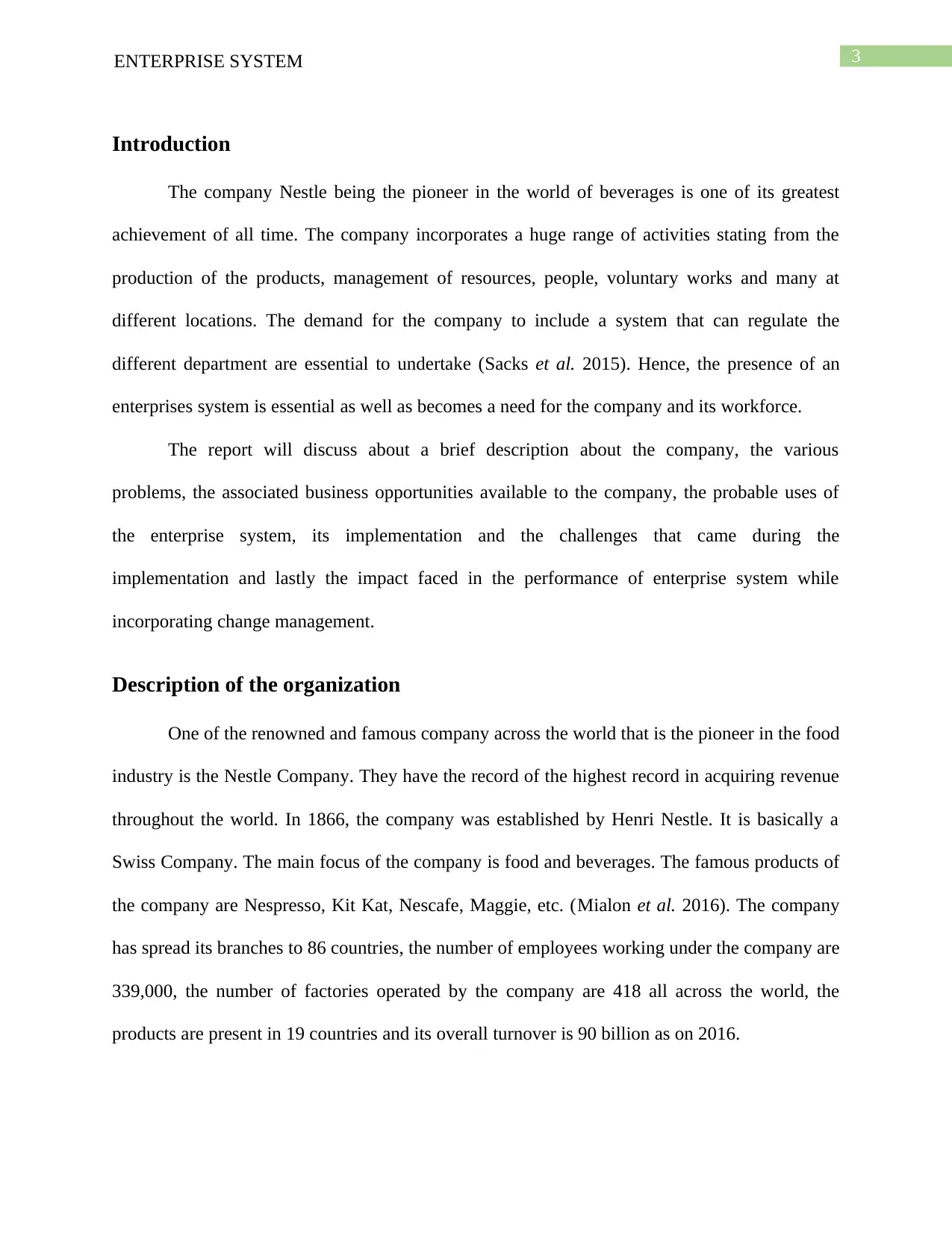
3ENTERPRISE SYSTEM
Introduction
The company Nestle being the pioneer in the world of beverages is one of its greatest
achievement of all time. The company incorporates a huge range of activities stating from the
production of the products, management of resources, people, voluntary works and many at
different locations. The demand for the company to include a system that can regulate the
different department are essential to undertake (Sacks et al. 2015). Hence, the presence of an
enterprises system is essential as well as becomes a need for the company and its workforce.
The report will discuss about a brief description about the company, the various
problems, the associated business opportunities available to the company, the probable uses of
the enterprise system, its implementation and the challenges that came during the
implementation and lastly the impact faced in the performance of enterprise system while
incorporating change management.
Description of the organization
One of the renowned and famous company across the world that is the pioneer in the food
industry is the Nestle Company. They have the record of the highest record in acquiring revenue
throughout the world. In 1866, the company was established by Henri Nestle. It is basically a
Swiss Company. The main focus of the company is food and beverages. The famous products of
the company are Nespresso, Kit Kat, Nescafe, Maggie, etc. (Mialon et al. 2016). The company
has spread its branches to 86 countries, the number of employees working under the company are
339,000, the number of factories operated by the company are 418 all across the world, the
products are present in 19 countries and its overall turnover is 90 billion as on 2016.
Introduction
The company Nestle being the pioneer in the world of beverages is one of its greatest
achievement of all time. The company incorporates a huge range of activities stating from the
production of the products, management of resources, people, voluntary works and many at
different locations. The demand for the company to include a system that can regulate the
different department are essential to undertake (Sacks et al. 2015). Hence, the presence of an
enterprises system is essential as well as becomes a need for the company and its workforce.
The report will discuss about a brief description about the company, the various
problems, the associated business opportunities available to the company, the probable uses of
the enterprise system, its implementation and the challenges that came during the
implementation and lastly the impact faced in the performance of enterprise system while
incorporating change management.
Description of the organization
One of the renowned and famous company across the world that is the pioneer in the food
industry is the Nestle Company. They have the record of the highest record in acquiring revenue
throughout the world. In 1866, the company was established by Henri Nestle. It is basically a
Swiss Company. The main focus of the company is food and beverages. The famous products of
the company are Nespresso, Kit Kat, Nescafe, Maggie, etc. (Mialon et al. 2016). The company
has spread its branches to 86 countries, the number of employees working under the company are
339,000, the number of factories operated by the company are 418 all across the world, the
products are present in 19 countries and its overall turnover is 90 billion as on 2016.
Secure Best Marks with AI Grader
Need help grading? Try our AI Grader for instant feedback on your assignments.
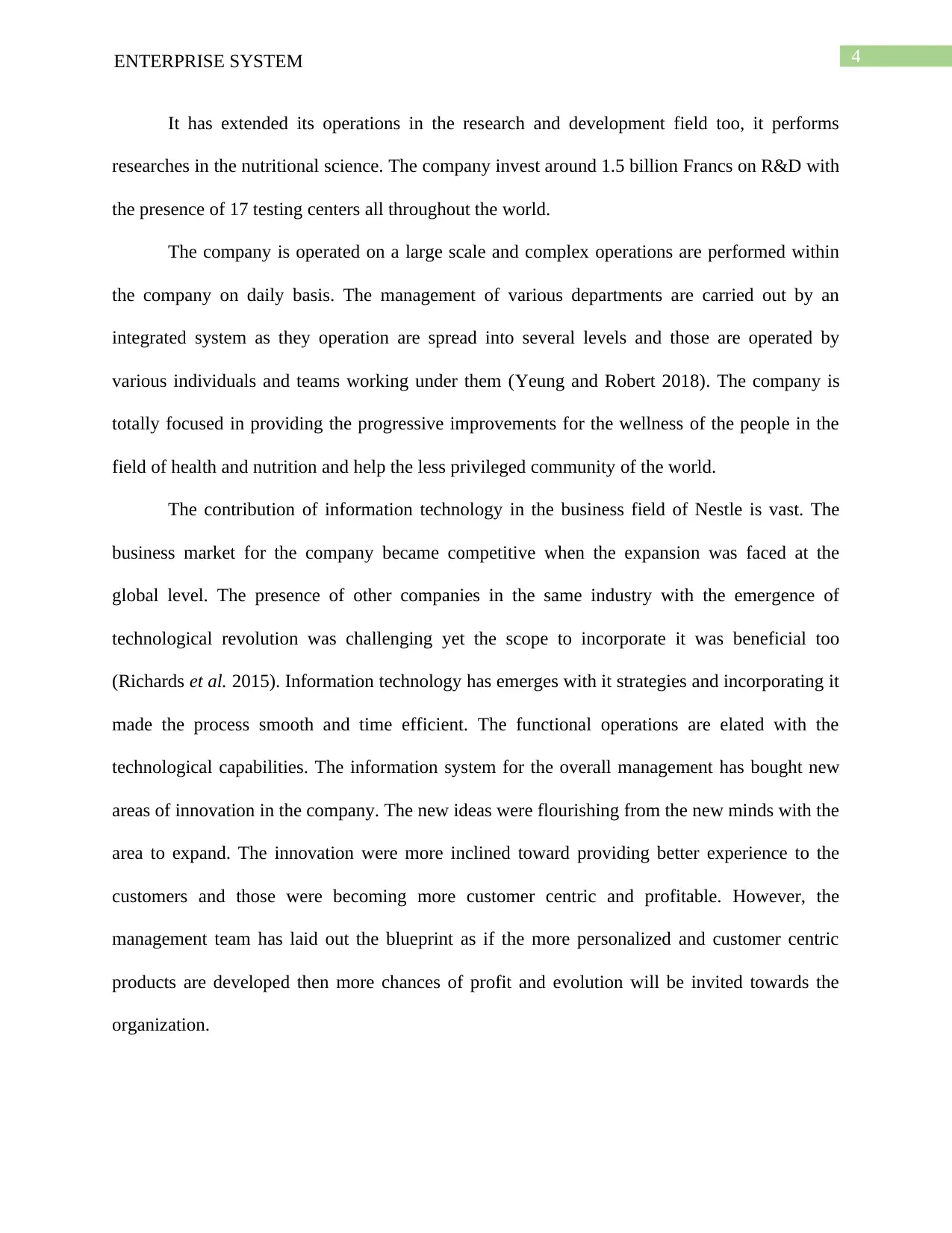
4ENTERPRISE SYSTEM
It has extended its operations in the research and development field too, it performs
researches in the nutritional science. The company invest around 1.5 billion Francs on R&D with
the presence of 17 testing centers all throughout the world.
The company is operated on a large scale and complex operations are performed within
the company on daily basis. The management of various departments are carried out by an
integrated system as they operation are spread into several levels and those are operated by
various individuals and teams working under them (Yeung and Robert 2018). The company is
totally focused in providing the progressive improvements for the wellness of the people in the
field of health and nutrition and help the less privileged community of the world.
The contribution of information technology in the business field of Nestle is vast. The
business market for the company became competitive when the expansion was faced at the
global level. The presence of other companies in the same industry with the emergence of
technological revolution was challenging yet the scope to incorporate it was beneficial too
(Richards et al. 2015). Information technology has emerges with it strategies and incorporating it
made the process smooth and time efficient. The functional operations are elated with the
technological capabilities. The information system for the overall management has bought new
areas of innovation in the company. The new ideas were flourishing from the new minds with the
area to expand. The innovation were more inclined toward providing better experience to the
customers and those were becoming more customer centric and profitable. However, the
management team has laid out the blueprint as if the more personalized and customer centric
products are developed then more chances of profit and evolution will be invited towards the
organization.
It has extended its operations in the research and development field too, it performs
researches in the nutritional science. The company invest around 1.5 billion Francs on R&D with
the presence of 17 testing centers all throughout the world.
The company is operated on a large scale and complex operations are performed within
the company on daily basis. The management of various departments are carried out by an
integrated system as they operation are spread into several levels and those are operated by
various individuals and teams working under them (Yeung and Robert 2018). The company is
totally focused in providing the progressive improvements for the wellness of the people in the
field of health and nutrition and help the less privileged community of the world.
The contribution of information technology in the business field of Nestle is vast. The
business market for the company became competitive when the expansion was faced at the
global level. The presence of other companies in the same industry with the emergence of
technological revolution was challenging yet the scope to incorporate it was beneficial too
(Richards et al. 2015). Information technology has emerges with it strategies and incorporating it
made the process smooth and time efficient. The functional operations are elated with the
technological capabilities. The information system for the overall management has bought new
areas of innovation in the company. The new ideas were flourishing from the new minds with the
area to expand. The innovation were more inclined toward providing better experience to the
customers and those were becoming more customer centric and profitable. However, the
management team has laid out the blueprint as if the more personalized and customer centric
products are developed then more chances of profit and evolution will be invited towards the
organization.
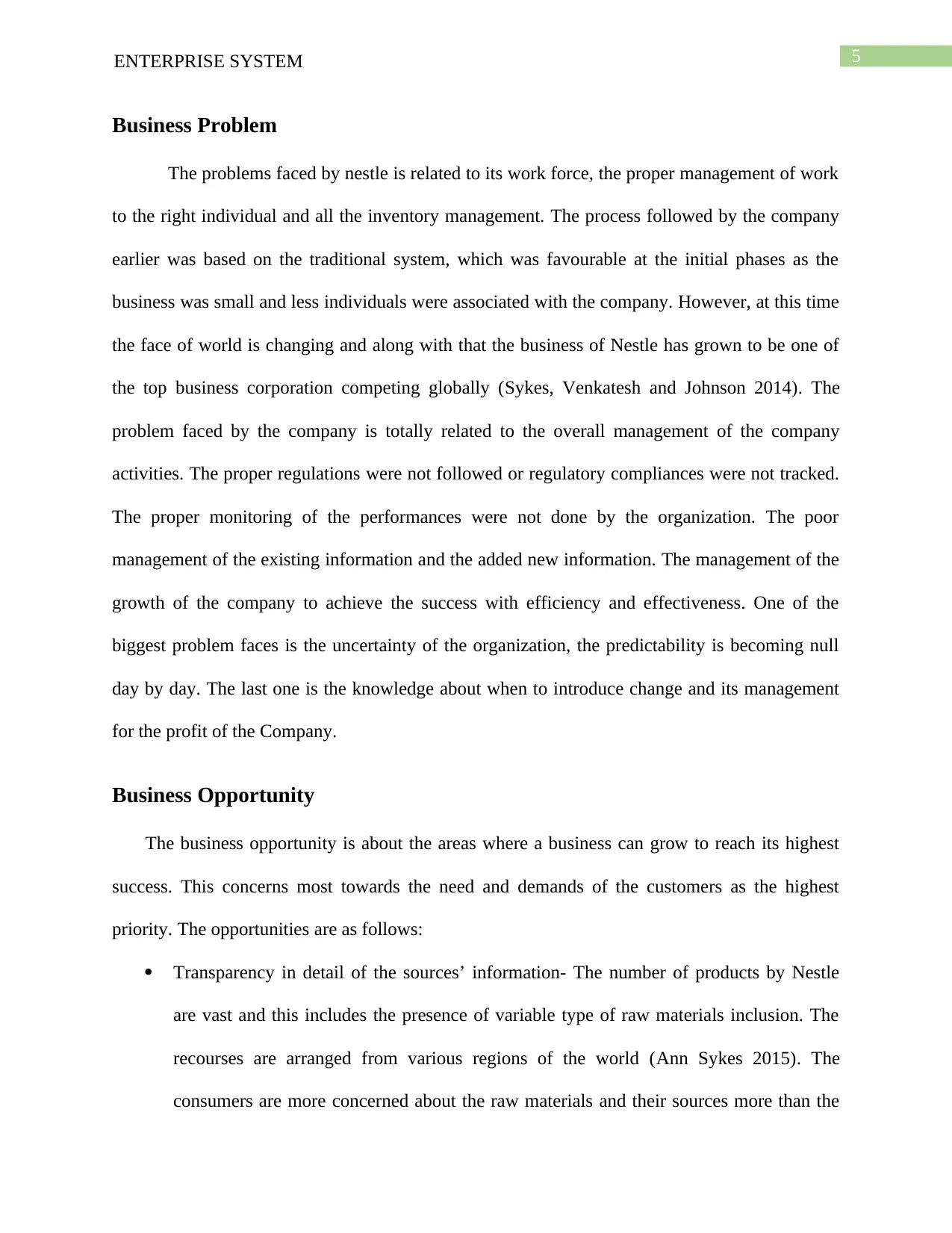
5ENTERPRISE SYSTEM
Business Problem
The problems faced by nestle is related to its work force, the proper management of work
to the right individual and all the inventory management. The process followed by the company
earlier was based on the traditional system, which was favourable at the initial phases as the
business was small and less individuals were associated with the company. However, at this time
the face of world is changing and along with that the business of Nestle has grown to be one of
the top business corporation competing globally (Sykes, Venkatesh and Johnson 2014). The
problem faced by the company is totally related to the overall management of the company
activities. The proper regulations were not followed or regulatory compliances were not tracked.
The proper monitoring of the performances were not done by the organization. The poor
management of the existing information and the added new information. The management of the
growth of the company to achieve the success with efficiency and effectiveness. One of the
biggest problem faces is the uncertainty of the organization, the predictability is becoming null
day by day. The last one is the knowledge about when to introduce change and its management
for the profit of the Company.
Business Opportunity
The business opportunity is about the areas where a business can grow to reach its highest
success. This concerns most towards the need and demands of the customers as the highest
priority. The opportunities are as follows:
Transparency in detail of the sources’ information- The number of products by Nestle
are vast and this includes the presence of variable type of raw materials inclusion. The
recourses are arranged from various regions of the world (Ann Sykes 2015). The
consumers are more concerned about the raw materials and their sources more than the
Business Problem
The problems faced by nestle is related to its work force, the proper management of work
to the right individual and all the inventory management. The process followed by the company
earlier was based on the traditional system, which was favourable at the initial phases as the
business was small and less individuals were associated with the company. However, at this time
the face of world is changing and along with that the business of Nestle has grown to be one of
the top business corporation competing globally (Sykes, Venkatesh and Johnson 2014). The
problem faced by the company is totally related to the overall management of the company
activities. The proper regulations were not followed or regulatory compliances were not tracked.
The proper monitoring of the performances were not done by the organization. The poor
management of the existing information and the added new information. The management of the
growth of the company to achieve the success with efficiency and effectiveness. One of the
biggest problem faces is the uncertainty of the organization, the predictability is becoming null
day by day. The last one is the knowledge about when to introduce change and its management
for the profit of the Company.
Business Opportunity
The business opportunity is about the areas where a business can grow to reach its highest
success. This concerns most towards the need and demands of the customers as the highest
priority. The opportunities are as follows:
Transparency in detail of the sources’ information- The number of products by Nestle
are vast and this includes the presence of variable type of raw materials inclusion. The
recourses are arranged from various regions of the world (Ann Sykes 2015). The
consumers are more concerned about the raw materials and their sources more than the
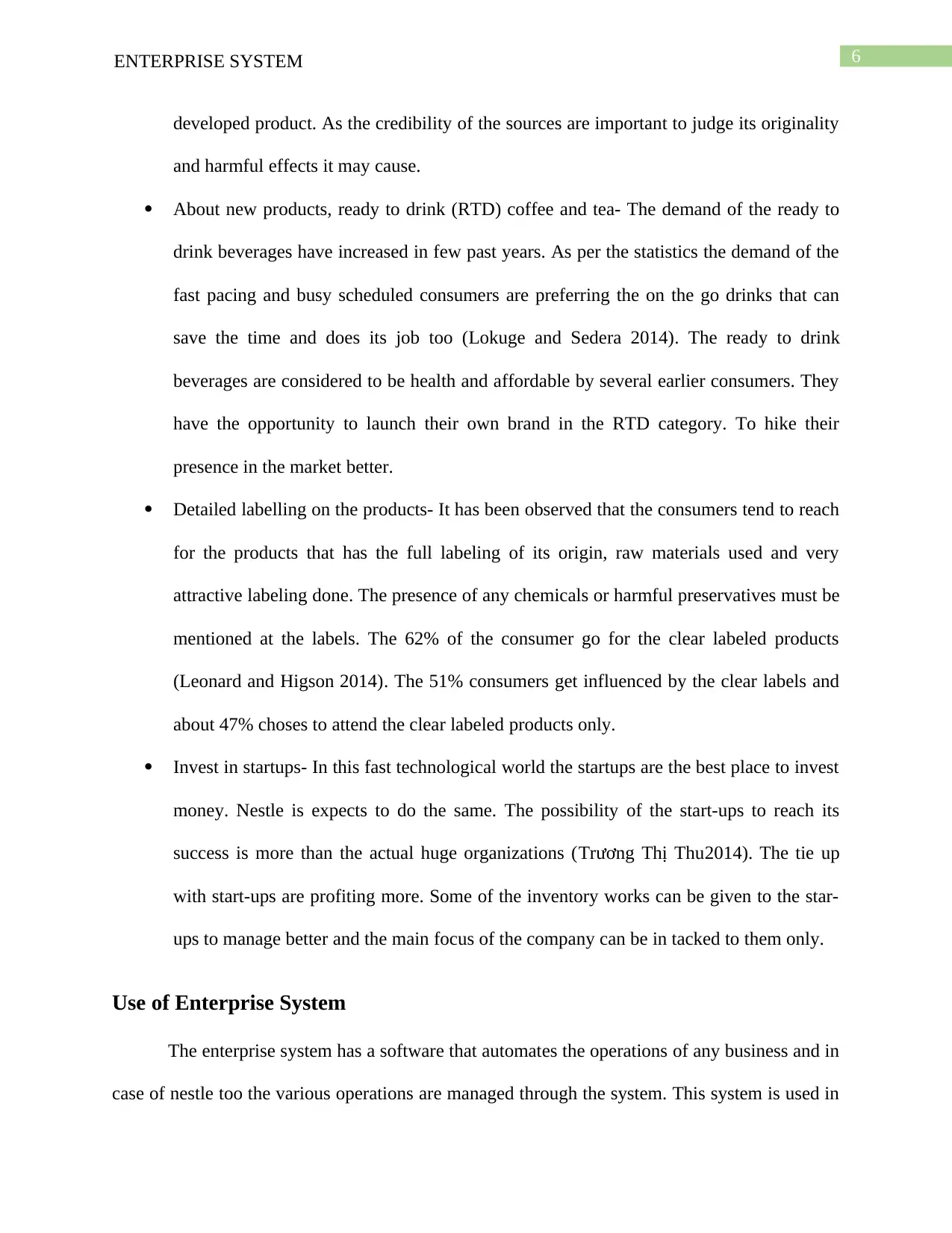
6ENTERPRISE SYSTEM
developed product. As the credibility of the sources are important to judge its originality
and harmful effects it may cause.
About new products, ready to drink (RTD) coffee and tea- The demand of the ready to
drink beverages have increased in few past years. As per the statistics the demand of the
fast pacing and busy scheduled consumers are preferring the on the go drinks that can
save the time and does its job too (Lokuge and Sedera 2014). The ready to drink
beverages are considered to be health and affordable by several earlier consumers. They
have the opportunity to launch their own brand in the RTD category. To hike their
presence in the market better.
Detailed labelling on the products- It has been observed that the consumers tend to reach
for the products that has the full labeling of its origin, raw materials used and very
attractive labeling done. The presence of any chemicals or harmful preservatives must be
mentioned at the labels. The 62% of the consumer go for the clear labeled products
(Leonard and Higson 2014). The 51% consumers get influenced by the clear labels and
about 47% choses to attend the clear labeled products only.
Invest in startups- In this fast technological world the startups are the best place to invest
money. Nestle is expects to do the same. The possibility of the start-ups to reach its
success is more than the actual huge organizations (Trương Thị Thu2014). The tie up
with start-ups are profiting more. Some of the inventory works can be given to the star-
ups to manage better and the main focus of the company can be in tacked to them only.
Use of Enterprise System
The enterprise system has a software that automates the operations of any business and in
case of nestle too the various operations are managed through the system. This system is used in
developed product. As the credibility of the sources are important to judge its originality
and harmful effects it may cause.
About new products, ready to drink (RTD) coffee and tea- The demand of the ready to
drink beverages have increased in few past years. As per the statistics the demand of the
fast pacing and busy scheduled consumers are preferring the on the go drinks that can
save the time and does its job too (Lokuge and Sedera 2014). The ready to drink
beverages are considered to be health and affordable by several earlier consumers. They
have the opportunity to launch their own brand in the RTD category. To hike their
presence in the market better.
Detailed labelling on the products- It has been observed that the consumers tend to reach
for the products that has the full labeling of its origin, raw materials used and very
attractive labeling done. The presence of any chemicals or harmful preservatives must be
mentioned at the labels. The 62% of the consumer go for the clear labeled products
(Leonard and Higson 2014). The 51% consumers get influenced by the clear labels and
about 47% choses to attend the clear labeled products only.
Invest in startups- In this fast technological world the startups are the best place to invest
money. Nestle is expects to do the same. The possibility of the start-ups to reach its
success is more than the actual huge organizations (Trương Thị Thu2014). The tie up
with start-ups are profiting more. Some of the inventory works can be given to the star-
ups to manage better and the main focus of the company can be in tacked to them only.
Use of Enterprise System
The enterprise system has a software that automates the operations of any business and in
case of nestle too the various operations are managed through the system. This system is used in
Paraphrase This Document
Need a fresh take? Get an instant paraphrase of this document with our AI Paraphraser
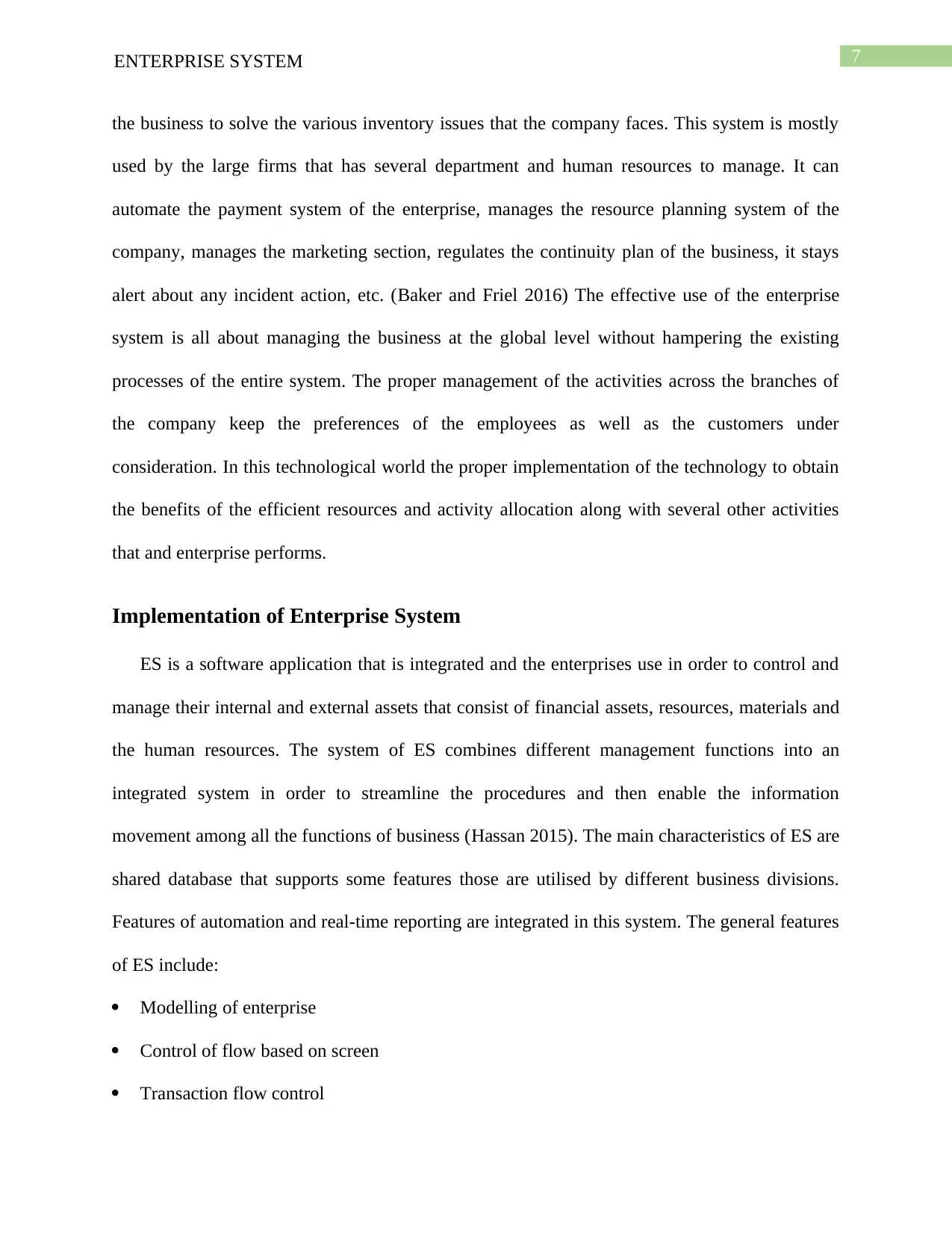
7ENTERPRISE SYSTEM
the business to solve the various inventory issues that the company faces. This system is mostly
used by the large firms that has several department and human resources to manage. It can
automate the payment system of the enterprise, manages the resource planning system of the
company, manages the marketing section, regulates the continuity plan of the business, it stays
alert about any incident action, etc. (Baker and Friel 2016) The effective use of the enterprise
system is all about managing the business at the global level without hampering the existing
processes of the entire system. The proper management of the activities across the branches of
the company keep the preferences of the employees as well as the customers under
consideration. In this technological world the proper implementation of the technology to obtain
the benefits of the efficient resources and activity allocation along with several other activities
that and enterprise performs.
Implementation of Enterprise System
ES is a software application that is integrated and the enterprises use in order to control and
manage their internal and external assets that consist of financial assets, resources, materials and
the human resources. The system of ES combines different management functions into an
integrated system in order to streamline the procedures and then enable the information
movement among all the functions of business (Hassan 2015). The main characteristics of ES are
shared database that supports some features those are utilised by different business divisions.
Features of automation and real-time reporting are integrated in this system. The general features
of ES include:
Modelling of enterprise
Control of flow based on screen
Transaction flow control
the business to solve the various inventory issues that the company faces. This system is mostly
used by the large firms that has several department and human resources to manage. It can
automate the payment system of the enterprise, manages the resource planning system of the
company, manages the marketing section, regulates the continuity plan of the business, it stays
alert about any incident action, etc. (Baker and Friel 2016) The effective use of the enterprise
system is all about managing the business at the global level without hampering the existing
processes of the entire system. The proper management of the activities across the branches of
the company keep the preferences of the employees as well as the customers under
consideration. In this technological world the proper implementation of the technology to obtain
the benefits of the efficient resources and activity allocation along with several other activities
that and enterprise performs.
Implementation of Enterprise System
ES is a software application that is integrated and the enterprises use in order to control and
manage their internal and external assets that consist of financial assets, resources, materials and
the human resources. The system of ES combines different management functions into an
integrated system in order to streamline the procedures and then enable the information
movement among all the functions of business (Hassan 2015). The main characteristics of ES are
shared database that supports some features those are utilised by different business divisions.
Features of automation and real-time reporting are integrated in this system. The general features
of ES include:
Modelling of enterprise
Control of flow based on screen
Transaction flow control
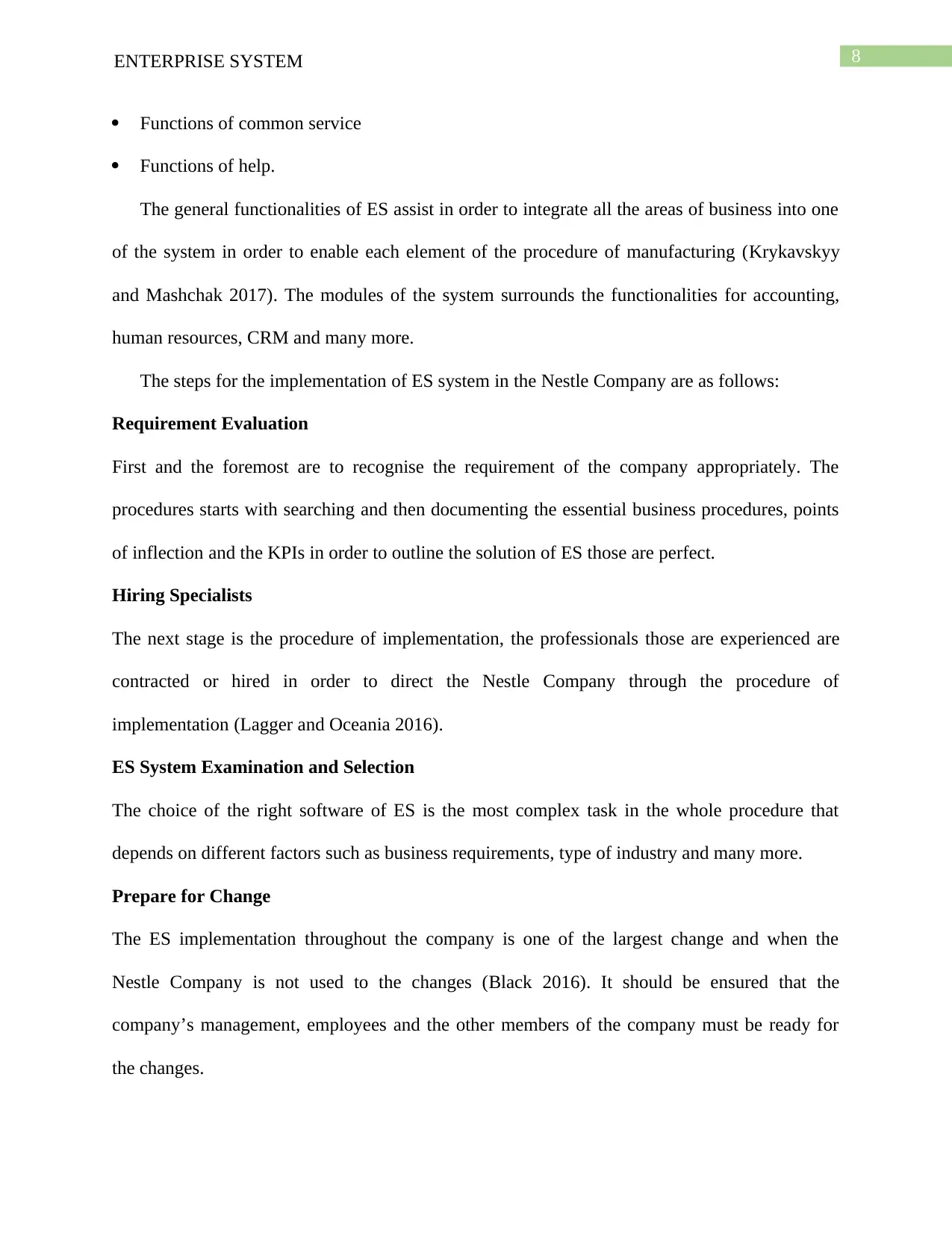
8ENTERPRISE SYSTEM
Functions of common service
Functions of help.
The general functionalities of ES assist in order to integrate all the areas of business into one
of the system in order to enable each element of the procedure of manufacturing (Krykavskyy
and Mashchak 2017). The modules of the system surrounds the functionalities for accounting,
human resources, CRM and many more.
The steps for the implementation of ES system in the Nestle Company are as follows:
Requirement Evaluation
First and the foremost are to recognise the requirement of the company appropriately. The
procedures starts with searching and then documenting the essential business procedures, points
of inflection and the KPIs in order to outline the solution of ES those are perfect.
Hiring Specialists
The next stage is the procedure of implementation, the professionals those are experienced are
contracted or hired in order to direct the Nestle Company through the procedure of
implementation (Lagger and Oceania 2016).
ES System Examination and Selection
The choice of the right software of ES is the most complex task in the whole procedure that
depends on different factors such as business requirements, type of industry and many more.
Prepare for Change
The ES implementation throughout the company is one of the largest change and when the
Nestle Company is not used to the changes (Black 2016). It should be ensured that the
company’s management, employees and the other members of the company must be ready for
the changes.
Functions of common service
Functions of help.
The general functionalities of ES assist in order to integrate all the areas of business into one
of the system in order to enable each element of the procedure of manufacturing (Krykavskyy
and Mashchak 2017). The modules of the system surrounds the functionalities for accounting,
human resources, CRM and many more.
The steps for the implementation of ES system in the Nestle Company are as follows:
Requirement Evaluation
First and the foremost are to recognise the requirement of the company appropriately. The
procedures starts with searching and then documenting the essential business procedures, points
of inflection and the KPIs in order to outline the solution of ES those are perfect.
Hiring Specialists
The next stage is the procedure of implementation, the professionals those are experienced are
contracted or hired in order to direct the Nestle Company through the procedure of
implementation (Lagger and Oceania 2016).
ES System Examination and Selection
The choice of the right software of ES is the most complex task in the whole procedure that
depends on different factors such as business requirements, type of industry and many more.
Prepare for Change
The ES implementation throughout the company is one of the largest change and when the
Nestle Company is not used to the changes (Black 2016). It should be ensured that the
company’s management, employees and the other members of the company must be ready for
the changes.
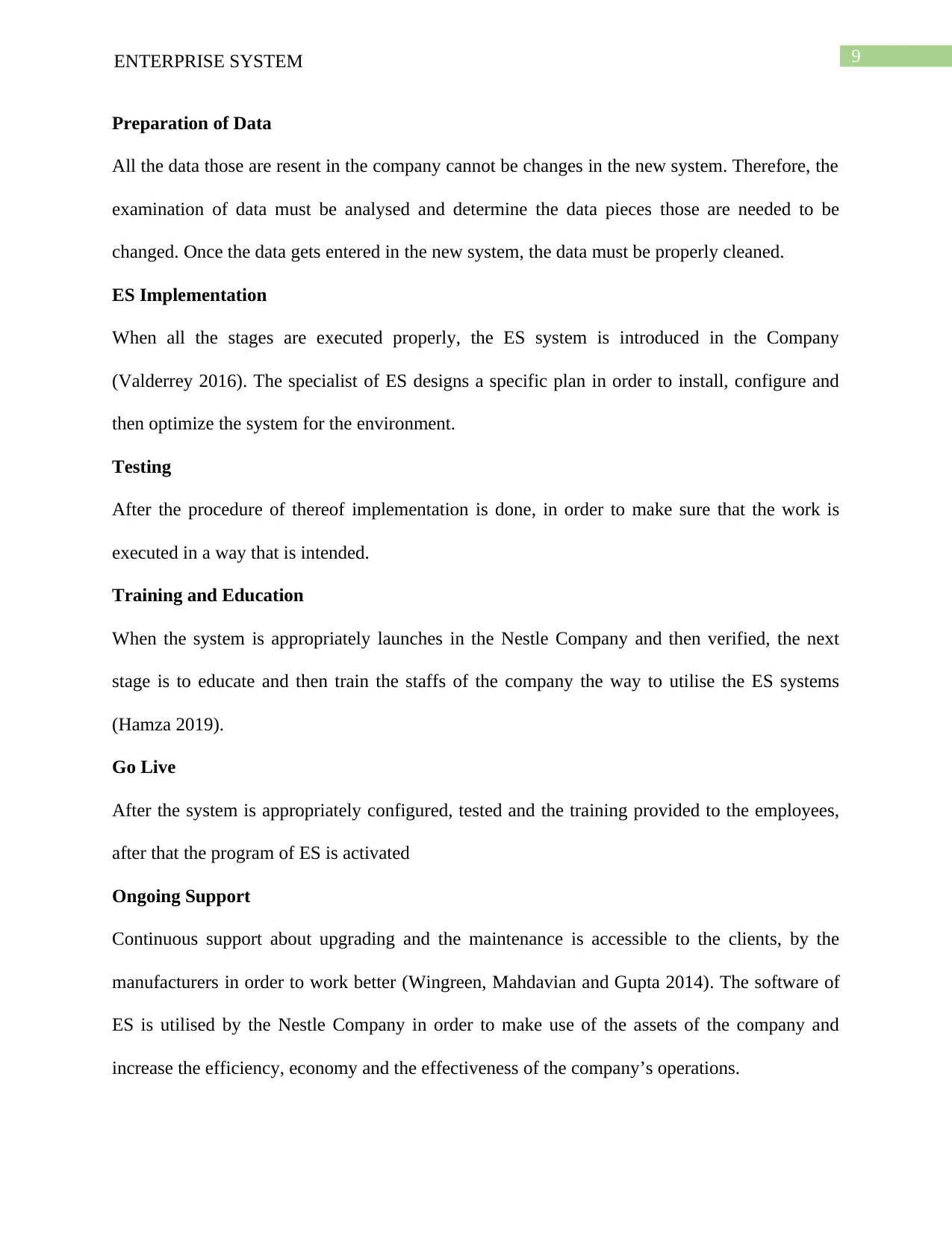
9ENTERPRISE SYSTEM
Preparation of Data
All the data those are resent in the company cannot be changes in the new system. Therefore, the
examination of data must be analysed and determine the data pieces those are needed to be
changed. Once the data gets entered in the new system, the data must be properly cleaned.
ES Implementation
When all the stages are executed properly, the ES system is introduced in the Company
(Valderrey 2016). The specialist of ES designs a specific plan in order to install, configure and
then optimize the system for the environment.
Testing
After the procedure of thereof implementation is done, in order to make sure that the work is
executed in a way that is intended.
Training and Education
When the system is appropriately launches in the Nestle Company and then verified, the next
stage is to educate and then train the staffs of the company the way to utilise the ES systems
(Hamza 2019).
Go Live
After the system is appropriately configured, tested and the training provided to the employees,
after that the program of ES is activated
Ongoing Support
Continuous support about upgrading and the maintenance is accessible to the clients, by the
manufacturers in order to work better (Wingreen, Mahdavian and Gupta 2014). The software of
ES is utilised by the Nestle Company in order to make use of the assets of the company and
increase the efficiency, economy and the effectiveness of the company’s operations.
Preparation of Data
All the data those are resent in the company cannot be changes in the new system. Therefore, the
examination of data must be analysed and determine the data pieces those are needed to be
changed. Once the data gets entered in the new system, the data must be properly cleaned.
ES Implementation
When all the stages are executed properly, the ES system is introduced in the Company
(Valderrey 2016). The specialist of ES designs a specific plan in order to install, configure and
then optimize the system for the environment.
Testing
After the procedure of thereof implementation is done, in order to make sure that the work is
executed in a way that is intended.
Training and Education
When the system is appropriately launches in the Nestle Company and then verified, the next
stage is to educate and then train the staffs of the company the way to utilise the ES systems
(Hamza 2019).
Go Live
After the system is appropriately configured, tested and the training provided to the employees,
after that the program of ES is activated
Ongoing Support
Continuous support about upgrading and the maintenance is accessible to the clients, by the
manufacturers in order to work better (Wingreen, Mahdavian and Gupta 2014). The software of
ES is utilised by the Nestle Company in order to make use of the assets of the company and
increase the efficiency, economy and the effectiveness of the company’s operations.
Secure Best Marks with AI Grader
Need help grading? Try our AI Grader for instant feedback on your assignments.
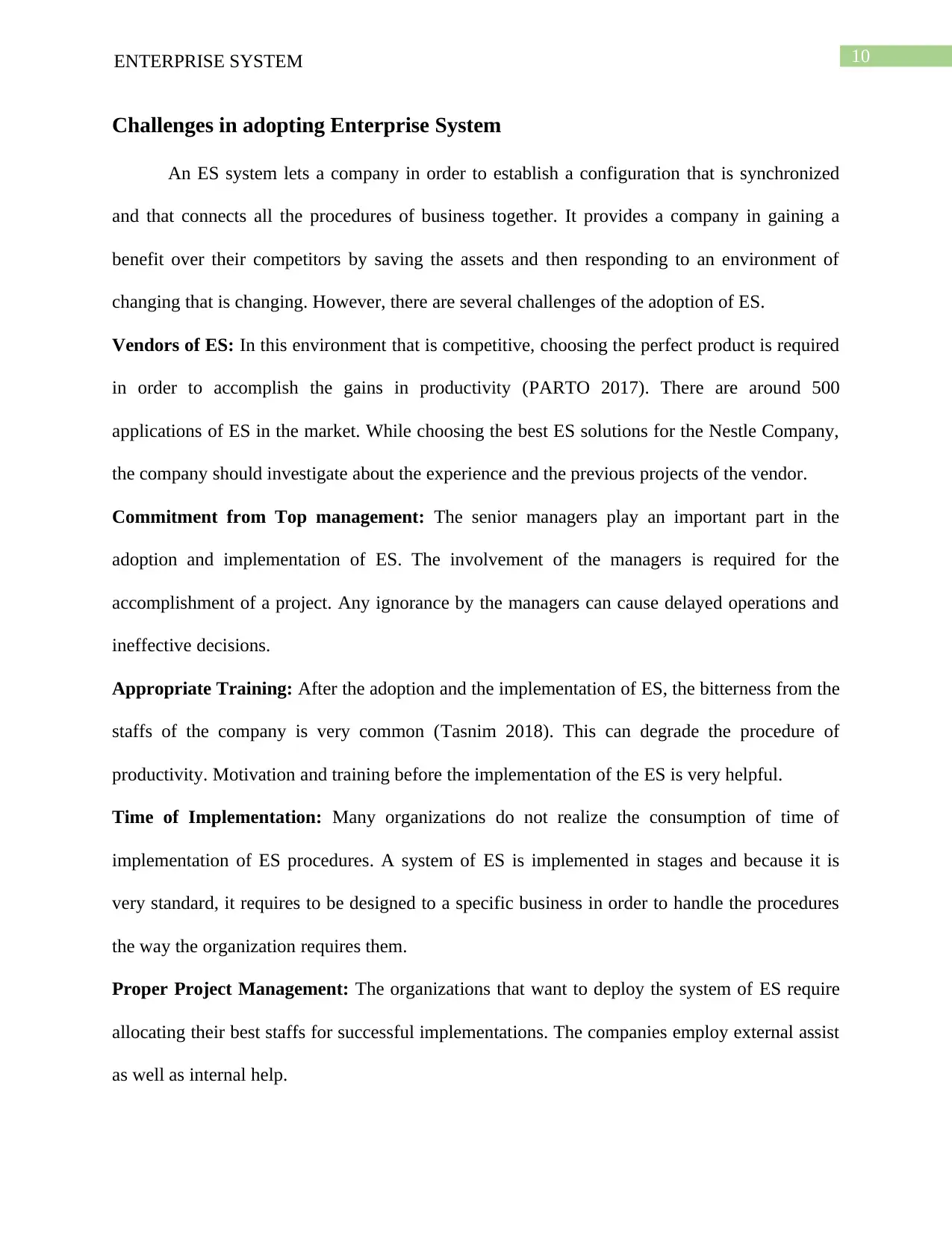
10ENTERPRISE SYSTEM
Challenges in adopting Enterprise System
An ES system lets a company in order to establish a configuration that is synchronized
and that connects all the procedures of business together. It provides a company in gaining a
benefit over their competitors by saving the assets and then responding to an environment of
changing that is changing. However, there are several challenges of the adoption of ES.
Vendors of ES: In this environment that is competitive, choosing the perfect product is required
in order to accomplish the gains in productivity (PARTO 2017). There are around 500
applications of ES in the market. While choosing the best ES solutions for the Nestle Company,
the company should investigate about the experience and the previous projects of the vendor.
Commitment from Top management: The senior managers play an important part in the
adoption and implementation of ES. The involvement of the managers is required for the
accomplishment of a project. Any ignorance by the managers can cause delayed operations and
ineffective decisions.
Appropriate Training: After the adoption and the implementation of ES, the bitterness from the
staffs of the company is very common (Tasnim 2018). This can degrade the procedure of
productivity. Motivation and training before the implementation of the ES is very helpful.
Time of Implementation: Many organizations do not realize the consumption of time of
implementation of ES procedures. A system of ES is implemented in stages and because it is
very standard, it requires to be designed to a specific business in order to handle the procedures
the way the organization requires them.
Proper Project Management: The organizations that want to deploy the system of ES require
allocating their best staffs for successful implementations. The companies employ external assist
as well as internal help.
Challenges in adopting Enterprise System
An ES system lets a company in order to establish a configuration that is synchronized
and that connects all the procedures of business together. It provides a company in gaining a
benefit over their competitors by saving the assets and then responding to an environment of
changing that is changing. However, there are several challenges of the adoption of ES.
Vendors of ES: In this environment that is competitive, choosing the perfect product is required
in order to accomplish the gains in productivity (PARTO 2017). There are around 500
applications of ES in the market. While choosing the best ES solutions for the Nestle Company,
the company should investigate about the experience and the previous projects of the vendor.
Commitment from Top management: The senior managers play an important part in the
adoption and implementation of ES. The involvement of the managers is required for the
accomplishment of a project. Any ignorance by the managers can cause delayed operations and
ineffective decisions.
Appropriate Training: After the adoption and the implementation of ES, the bitterness from the
staffs of the company is very common (Tasnim 2018). This can degrade the procedure of
productivity. Motivation and training before the implementation of the ES is very helpful.
Time of Implementation: Many organizations do not realize the consumption of time of
implementation of ES procedures. A system of ES is implemented in stages and because it is
very standard, it requires to be designed to a specific business in order to handle the procedures
the way the organization requires them.
Proper Project Management: The organizations that want to deploy the system of ES require
allocating their best staffs for successful implementations. The companies employ external assist
as well as internal help.
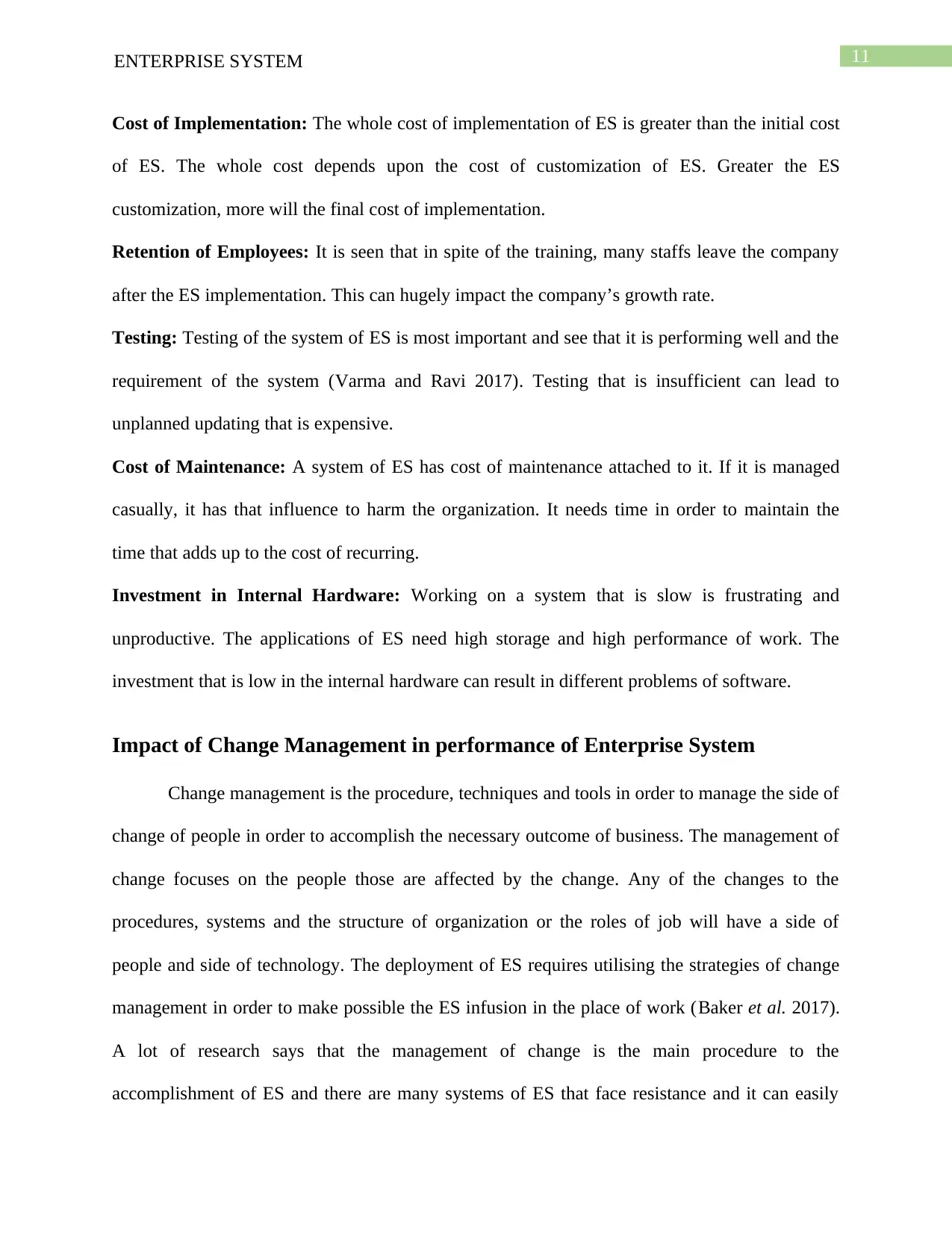
11ENTERPRISE SYSTEM
Cost of Implementation: The whole cost of implementation of ES is greater than the initial cost
of ES. The whole cost depends upon the cost of customization of ES. Greater the ES
customization, more will the final cost of implementation.
Retention of Employees: It is seen that in spite of the training, many staffs leave the company
after the ES implementation. This can hugely impact the company’s growth rate.
Testing: Testing of the system of ES is most important and see that it is performing well and the
requirement of the system (Varma and Ravi 2017). Testing that is insufficient can lead to
unplanned updating that is expensive.
Cost of Maintenance: A system of ES has cost of maintenance attached to it. If it is managed
casually, it has that influence to harm the organization. It needs time in order to maintain the
time that adds up to the cost of recurring.
Investment in Internal Hardware: Working on a system that is slow is frustrating and
unproductive. The applications of ES need high storage and high performance of work. The
investment that is low in the internal hardware can result in different problems of software.
Impact of Change Management in performance of Enterprise System
Change management is the procedure, techniques and tools in order to manage the side of
change of people in order to accomplish the necessary outcome of business. The management of
change focuses on the people those are affected by the change. Any of the changes to the
procedures, systems and the structure of organization or the roles of job will have a side of
people and side of technology. The deployment of ES requires utilising the strategies of change
management in order to make possible the ES infusion in the place of work (Baker et al. 2017).
A lot of research says that the management of change is the main procedure to the
accomplishment of ES and there are many systems of ES that face resistance and it can easily
Cost of Implementation: The whole cost of implementation of ES is greater than the initial cost
of ES. The whole cost depends upon the cost of customization of ES. Greater the ES
customization, more will the final cost of implementation.
Retention of Employees: It is seen that in spite of the training, many staffs leave the company
after the ES implementation. This can hugely impact the company’s growth rate.
Testing: Testing of the system of ES is most important and see that it is performing well and the
requirement of the system (Varma and Ravi 2017). Testing that is insufficient can lead to
unplanned updating that is expensive.
Cost of Maintenance: A system of ES has cost of maintenance attached to it. If it is managed
casually, it has that influence to harm the organization. It needs time in order to maintain the
time that adds up to the cost of recurring.
Investment in Internal Hardware: Working on a system that is slow is frustrating and
unproductive. The applications of ES need high storage and high performance of work. The
investment that is low in the internal hardware can result in different problems of software.
Impact of Change Management in performance of Enterprise System
Change management is the procedure, techniques and tools in order to manage the side of
change of people in order to accomplish the necessary outcome of business. The management of
change focuses on the people those are affected by the change. Any of the changes to the
procedures, systems and the structure of organization or the roles of job will have a side of
people and side of technology. The deployment of ES requires utilising the strategies of change
management in order to make possible the ES infusion in the place of work (Baker et al. 2017).
A lot of research says that the management of change is the main procedure to the
accomplishment of ES and there are many systems of ES that face resistance and it can easily
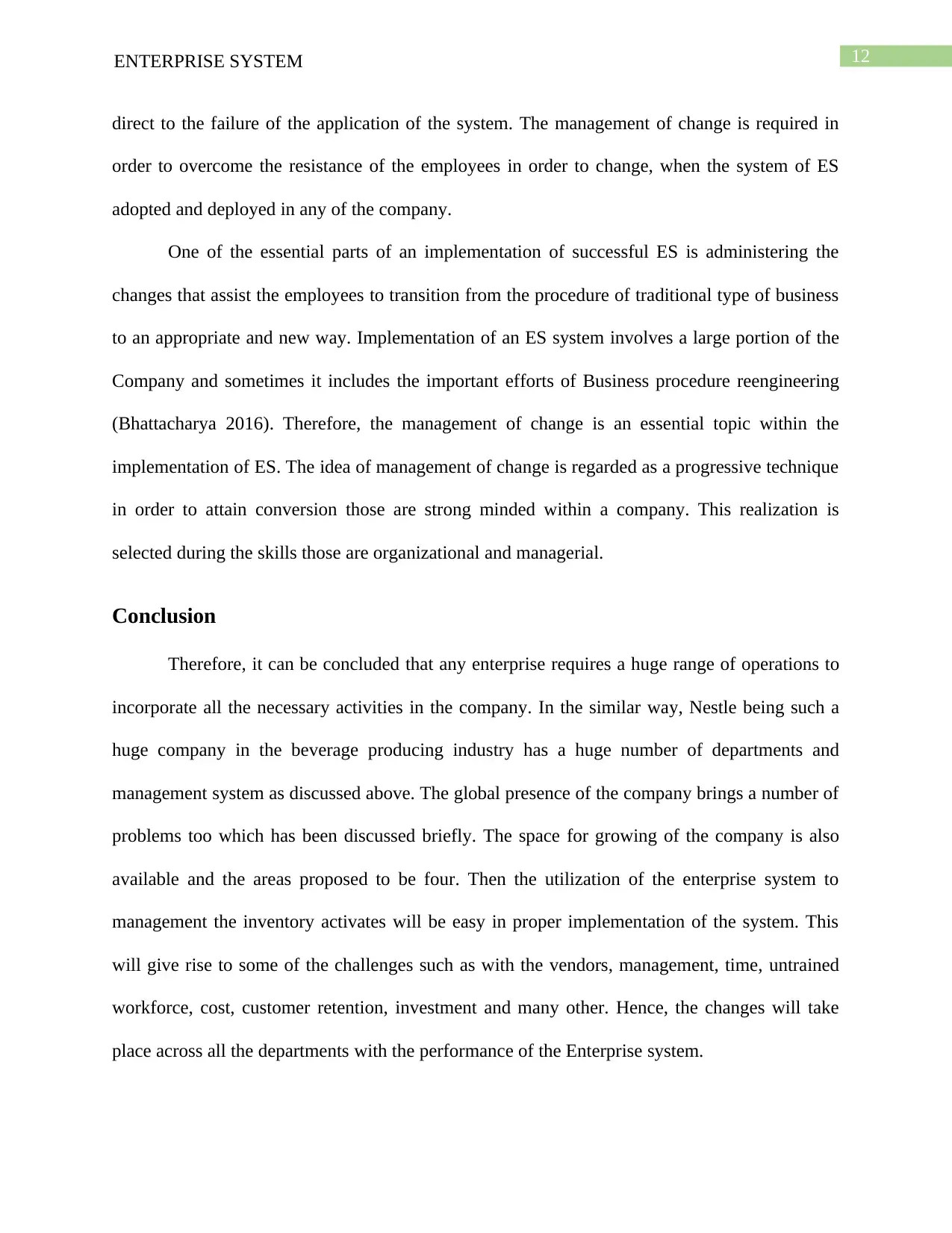
12ENTERPRISE SYSTEM
direct to the failure of the application of the system. The management of change is required in
order to overcome the resistance of the employees in order to change, when the system of ES
adopted and deployed in any of the company.
One of the essential parts of an implementation of successful ES is administering the
changes that assist the employees to transition from the procedure of traditional type of business
to an appropriate and new way. Implementation of an ES system involves a large portion of the
Company and sometimes it includes the important efforts of Business procedure reengineering
(Bhattacharya 2016). Therefore, the management of change is an essential topic within the
implementation of ES. The idea of management of change is regarded as a progressive technique
in order to attain conversion those are strong minded within a company. This realization is
selected during the skills those are organizational and managerial.
Conclusion
Therefore, it can be concluded that any enterprise requires a huge range of operations to
incorporate all the necessary activities in the company. In the similar way, Nestle being such a
huge company in the beverage producing industry has a huge number of departments and
management system as discussed above. The global presence of the company brings a number of
problems too which has been discussed briefly. The space for growing of the company is also
available and the areas proposed to be four. Then the utilization of the enterprise system to
management the inventory activates will be easy in proper implementation of the system. This
will give rise to some of the challenges such as with the vendors, management, time, untrained
workforce, cost, customer retention, investment and many other. Hence, the changes will take
place across all the departments with the performance of the Enterprise system.
direct to the failure of the application of the system. The management of change is required in
order to overcome the resistance of the employees in order to change, when the system of ES
adopted and deployed in any of the company.
One of the essential parts of an implementation of successful ES is administering the
changes that assist the employees to transition from the procedure of traditional type of business
to an appropriate and new way. Implementation of an ES system involves a large portion of the
Company and sometimes it includes the important efforts of Business procedure reengineering
(Bhattacharya 2016). Therefore, the management of change is an essential topic within the
implementation of ES. The idea of management of change is regarded as a progressive technique
in order to attain conversion those are strong minded within a company. This realization is
selected during the skills those are organizational and managerial.
Conclusion
Therefore, it can be concluded that any enterprise requires a huge range of operations to
incorporate all the necessary activities in the company. In the similar way, Nestle being such a
huge company in the beverage producing industry has a huge number of departments and
management system as discussed above. The global presence of the company brings a number of
problems too which has been discussed briefly. The space for growing of the company is also
available and the areas proposed to be four. Then the utilization of the enterprise system to
management the inventory activates will be easy in proper implementation of the system. This
will give rise to some of the challenges such as with the vendors, management, time, untrained
workforce, cost, customer retention, investment and many other. Hence, the changes will take
place across all the departments with the performance of the Enterprise system.
Paraphrase This Document
Need a fresh take? Get an instant paraphrase of this document with our AI Paraphraser

13ENTERPRISE SYSTEM
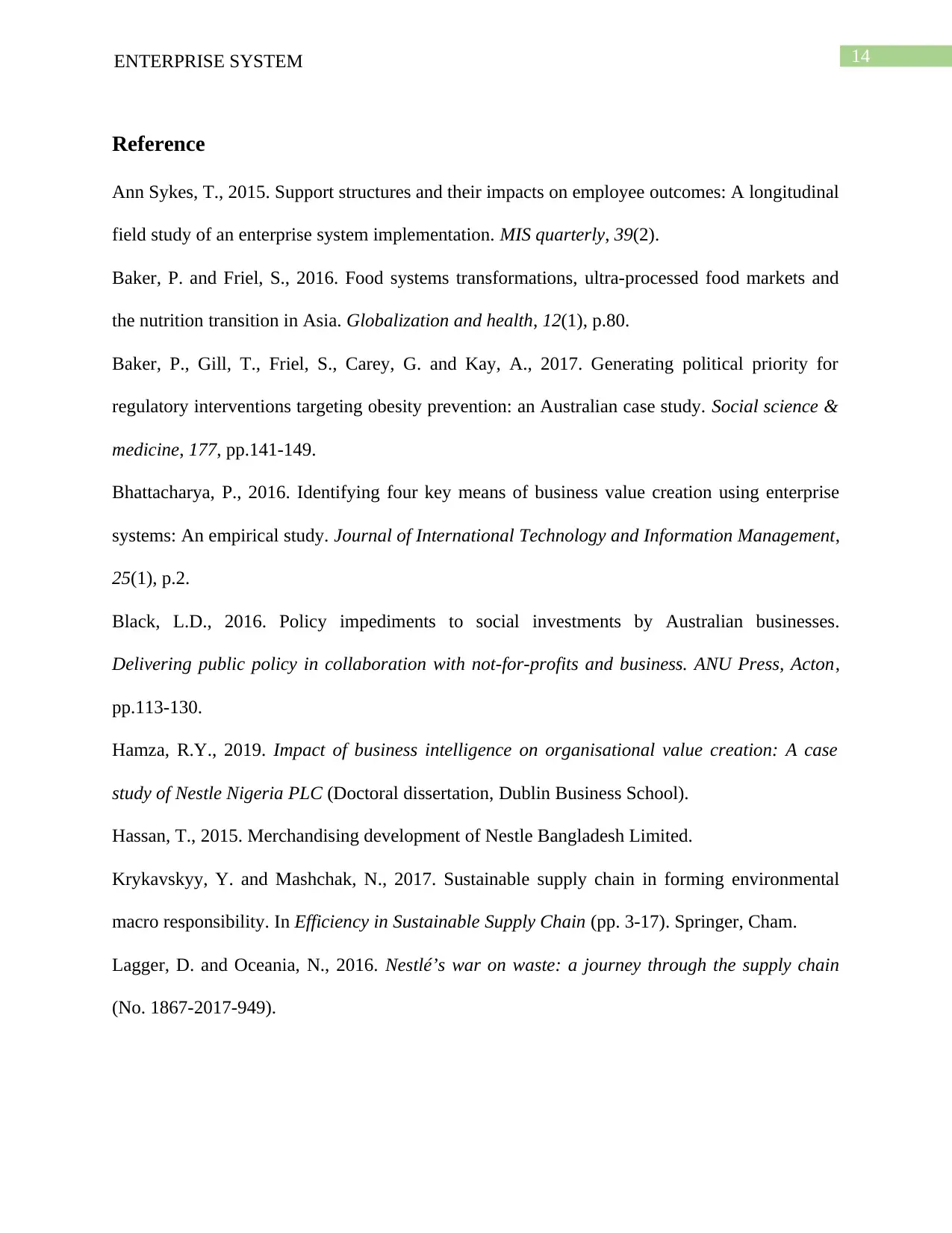
14ENTERPRISE SYSTEM
Reference
Ann Sykes, T., 2015. Support structures and their impacts on employee outcomes: A longitudinal
field study of an enterprise system implementation. MIS quarterly, 39(2).
Baker, P. and Friel, S., 2016. Food systems transformations, ultra-processed food markets and
the nutrition transition in Asia. Globalization and health, 12(1), p.80.
Baker, P., Gill, T., Friel, S., Carey, G. and Kay, A., 2017. Generating political priority for
regulatory interventions targeting obesity prevention: an Australian case study. Social science &
medicine, 177, pp.141-149.
Bhattacharya, P., 2016. Identifying four key means of business value creation using enterprise
systems: An empirical study. Journal of International Technology and Information Management,
25(1), p.2.
Black, L.D., 2016. Policy impediments to social investments by Australian businesses.
Delivering public policy in collaboration with not-for-profits and business. ANU Press, Acton,
pp.113-130.
Hamza, R.Y., 2019. Impact of business intelligence on organisational value creation: A case
study of Nestle Nigeria PLC (Doctoral dissertation, Dublin Business School).
Hassan, T., 2015. Merchandising development of Nestle Bangladesh Limited.
Krykavskyy, Y. and Mashchak, N., 2017. Sustainable supply chain in forming environmental
macro responsibility. In Efficiency in Sustainable Supply Chain (pp. 3-17). Springer, Cham.
Lagger, D. and Oceania, N., 2016. Nestlé’s war on waste: a journey through the supply chain
(No. 1867-2017-949).
Reference
Ann Sykes, T., 2015. Support structures and their impacts on employee outcomes: A longitudinal
field study of an enterprise system implementation. MIS quarterly, 39(2).
Baker, P. and Friel, S., 2016. Food systems transformations, ultra-processed food markets and
the nutrition transition in Asia. Globalization and health, 12(1), p.80.
Baker, P., Gill, T., Friel, S., Carey, G. and Kay, A., 2017. Generating political priority for
regulatory interventions targeting obesity prevention: an Australian case study. Social science &
medicine, 177, pp.141-149.
Bhattacharya, P., 2016. Identifying four key means of business value creation using enterprise
systems: An empirical study. Journal of International Technology and Information Management,
25(1), p.2.
Black, L.D., 2016. Policy impediments to social investments by Australian businesses.
Delivering public policy in collaboration with not-for-profits and business. ANU Press, Acton,
pp.113-130.
Hamza, R.Y., 2019. Impact of business intelligence on organisational value creation: A case
study of Nestle Nigeria PLC (Doctoral dissertation, Dublin Business School).
Hassan, T., 2015. Merchandising development of Nestle Bangladesh Limited.
Krykavskyy, Y. and Mashchak, N., 2017. Sustainable supply chain in forming environmental
macro responsibility. In Efficiency in Sustainable Supply Chain (pp. 3-17). Springer, Cham.
Lagger, D. and Oceania, N., 2016. Nestlé’s war on waste: a journey through the supply chain
(No. 1867-2017-949).
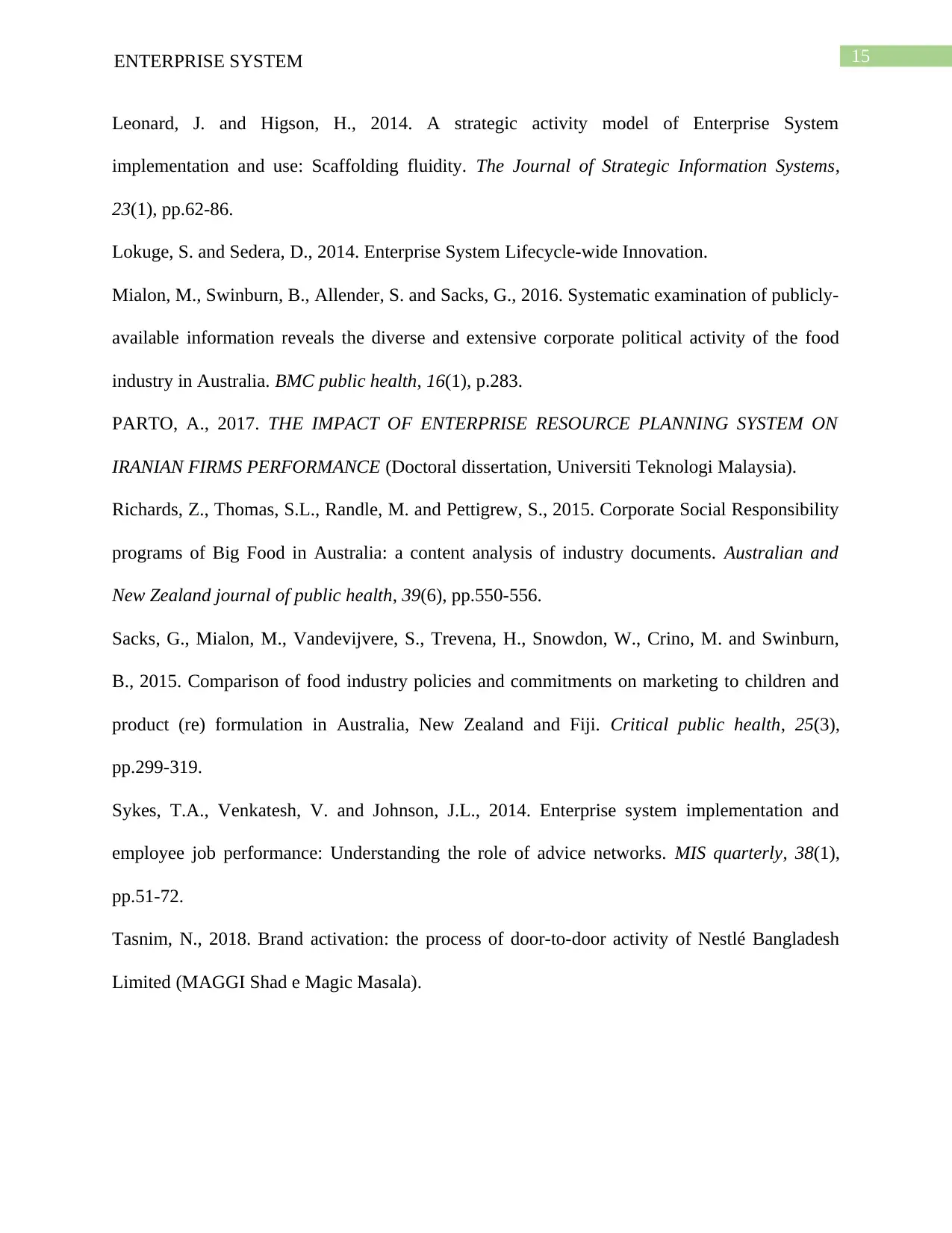
15ENTERPRISE SYSTEM
Leonard, J. and Higson, H., 2014. A strategic activity model of Enterprise System
implementation and use: Scaffolding fluidity. The Journal of Strategic Information Systems,
23(1), pp.62-86.
Lokuge, S. and Sedera, D., 2014. Enterprise System Lifecycle-wide Innovation.
Mialon, M., Swinburn, B., Allender, S. and Sacks, G., 2016. Systematic examination of publicly-
available information reveals the diverse and extensive corporate political activity of the food
industry in Australia. BMC public health, 16(1), p.283.
PARTO, A., 2017. THE IMPACT OF ENTERPRISE RESOURCE PLANNING SYSTEM ON
IRANIAN FIRMS PERFORMANCE (Doctoral dissertation, Universiti Teknologi Malaysia).
Richards, Z., Thomas, S.L., Randle, M. and Pettigrew, S., 2015. Corporate Social Responsibility
programs of Big Food in Australia: a content analysis of industry documents. Australian and
New Zealand journal of public health, 39(6), pp.550-556.
Sacks, G., Mialon, M., Vandevijvere, S., Trevena, H., Snowdon, W., Crino, M. and Swinburn,
B., 2015. Comparison of food industry policies and commitments on marketing to children and
product (re) formulation in Australia, New Zealand and Fiji. Critical public health, 25(3),
pp.299-319.
Sykes, T.A., Venkatesh, V. and Johnson, J.L., 2014. Enterprise system implementation and
employee job performance: Understanding the role of advice networks. MIS quarterly, 38(1),
pp.51-72.
Tasnim, N., 2018. Brand activation: the process of door-to-door activity of Nestlé Bangladesh
Limited (MAGGI Shad e Magic Masala).
Leonard, J. and Higson, H., 2014. A strategic activity model of Enterprise System
implementation and use: Scaffolding fluidity. The Journal of Strategic Information Systems,
23(1), pp.62-86.
Lokuge, S. and Sedera, D., 2014. Enterprise System Lifecycle-wide Innovation.
Mialon, M., Swinburn, B., Allender, S. and Sacks, G., 2016. Systematic examination of publicly-
available information reveals the diverse and extensive corporate political activity of the food
industry in Australia. BMC public health, 16(1), p.283.
PARTO, A., 2017. THE IMPACT OF ENTERPRISE RESOURCE PLANNING SYSTEM ON
IRANIAN FIRMS PERFORMANCE (Doctoral dissertation, Universiti Teknologi Malaysia).
Richards, Z., Thomas, S.L., Randle, M. and Pettigrew, S., 2015. Corporate Social Responsibility
programs of Big Food in Australia: a content analysis of industry documents. Australian and
New Zealand journal of public health, 39(6), pp.550-556.
Sacks, G., Mialon, M., Vandevijvere, S., Trevena, H., Snowdon, W., Crino, M. and Swinburn,
B., 2015. Comparison of food industry policies and commitments on marketing to children and
product (re) formulation in Australia, New Zealand and Fiji. Critical public health, 25(3),
pp.299-319.
Sykes, T.A., Venkatesh, V. and Johnson, J.L., 2014. Enterprise system implementation and
employee job performance: Understanding the role of advice networks. MIS quarterly, 38(1),
pp.51-72.
Tasnim, N., 2018. Brand activation: the process of door-to-door activity of Nestlé Bangladesh
Limited (MAGGI Shad e Magic Masala).
Secure Best Marks with AI Grader
Need help grading? Try our AI Grader for instant feedback on your assignments.
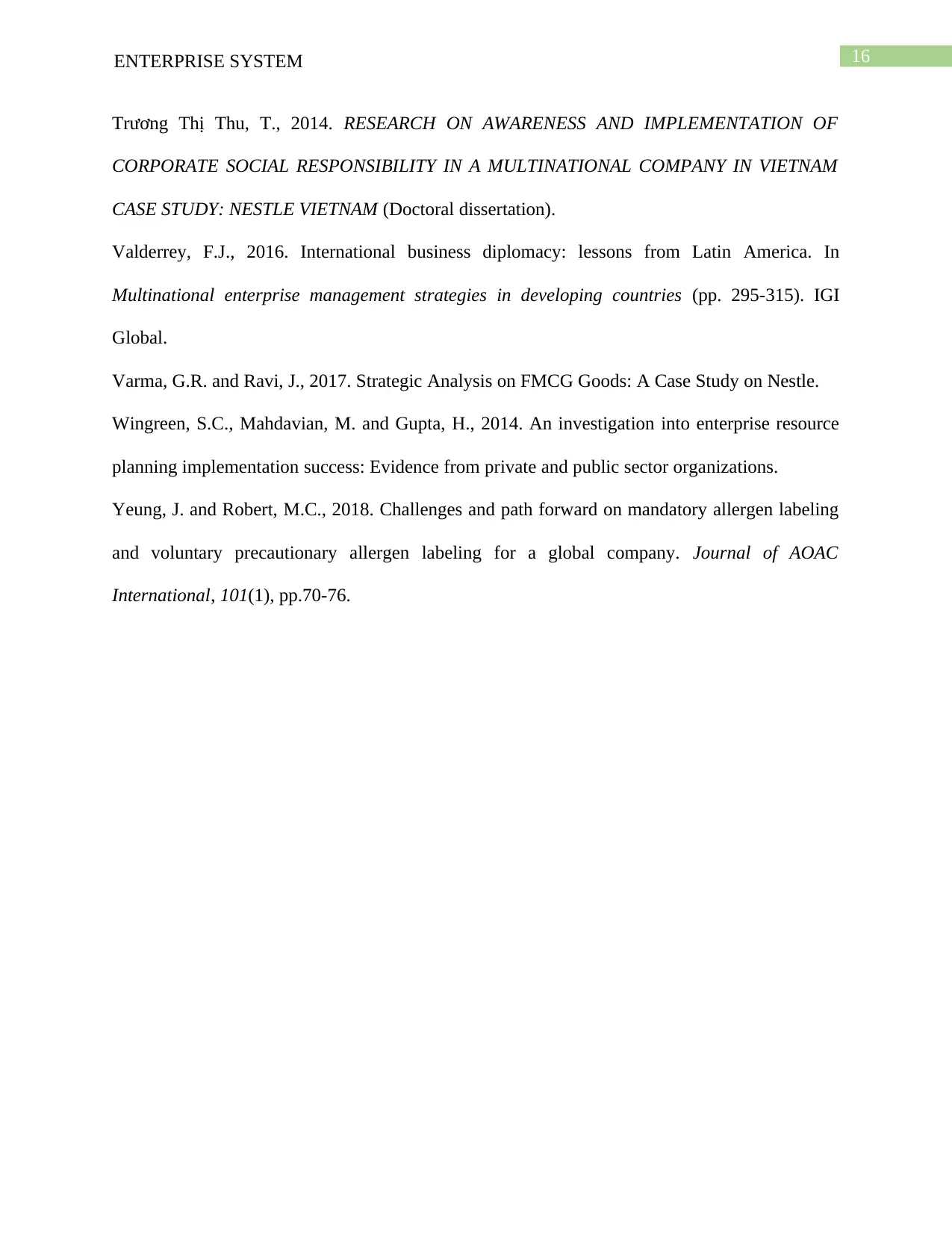
16ENTERPRISE SYSTEM
Trương Thị Thu, T., 2014. RESEARCH ON AWARENESS AND IMPLEMENTATION OF
CORPORATE SOCIAL RESPONSIBILITY IN A MULTINATIONAL COMPANY IN VIETNAM
CASE STUDY: NESTLE VIETNAM (Doctoral dissertation).
Valderrey, F.J., 2016. International business diplomacy: lessons from Latin America. In
Multinational enterprise management strategies in developing countries (pp. 295-315). IGI
Global.
Varma, G.R. and Ravi, J., 2017. Strategic Analysis on FMCG Goods: A Case Study on Nestle.
Wingreen, S.C., Mahdavian, M. and Gupta, H., 2014. An investigation into enterprise resource
planning implementation success: Evidence from private and public sector organizations.
Yeung, J. and Robert, M.C., 2018. Challenges and path forward on mandatory allergen labeling
and voluntary precautionary allergen labeling for a global company. Journal of AOAC
International, 101(1), pp.70-76.
Trương Thị Thu, T., 2014. RESEARCH ON AWARENESS AND IMPLEMENTATION OF
CORPORATE SOCIAL RESPONSIBILITY IN A MULTINATIONAL COMPANY IN VIETNAM
CASE STUDY: NESTLE VIETNAM (Doctoral dissertation).
Valderrey, F.J., 2016. International business diplomacy: lessons from Latin America. In
Multinational enterprise management strategies in developing countries (pp. 295-315). IGI
Global.
Varma, G.R. and Ravi, J., 2017. Strategic Analysis on FMCG Goods: A Case Study on Nestle.
Wingreen, S.C., Mahdavian, M. and Gupta, H., 2014. An investigation into enterprise resource
planning implementation success: Evidence from private and public sector organizations.
Yeung, J. and Robert, M.C., 2018. Challenges and path forward on mandatory allergen labeling
and voluntary precautionary allergen labeling for a global company. Journal of AOAC
International, 101(1), pp.70-76.
1 out of 17
Related Documents
Your All-in-One AI-Powered Toolkit for Academic Success.
+13062052269
info@desklib.com
Available 24*7 on WhatsApp / Email
![[object Object]](/_next/static/media/star-bottom.7253800d.svg)
Unlock your academic potential
© 2024 | Zucol Services PVT LTD | All rights reserved.





